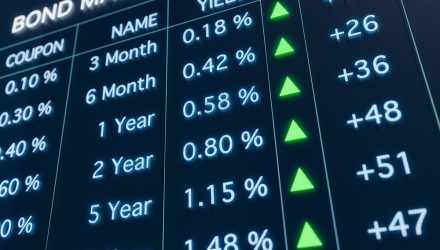Over the past 12-24 months of rate hikes, short-term and ultra-short-term bond ETFs have served income-seeking investors well. But as interest rates continue to rise, exposures farther out on the curve have begun to offer attractive yields, too. As a result, many investors are now seeking to add duration back into their core fixed income portfolios.
While measured in years, duration isn’t the same thing as maturity. Duration is a measure of a fixed income investment’s sensitivity to interest rate changes. The higher the duration, the more that investment’s value will change with every rate shift, up or down.
Long-term bond ETFs typically hold portfolios of bonds whose cumulative duration is of 10-20 years. Some extended duration bond ETFs may sport much higher durations, however.
In this article, we examine three long-term bond ETFs from Vanguard that provide higher duration exposures at low-cost.
Vanguard Long-Term Treasury ETF (VGLT)
The $7.2 billion Vanguard Long-Term Treasury ETF (VGLT) is one of the largest and most liquid Treasury funds in its category. The fund, which primarily invests in U.S. Treasuries with maturities between 10 and 25 years, currently has a 30-day SEC yield of 4.35%. In comparison, the Vanguard High Dividend ETF (VYM), which sources income from the equity markets instead, has a 30-day SEC yield of 3.08%. (Source: Vanguard.)
VGLT isn’t the cheapest long-term Treasury ETF on the market. However, with an expense ratio of just 0.04%, it’s not exactly expensive, either. Its low cost has made it a popular option for core Treasuries exposures, and the fund has seen inflows of $3.6 billion year-to-date.
VGLT’s average duration is 15.8 years.
See more: “Treasury ETFs See Strong Flows in 2023“
Vanguard Long-Term Corporate Bond ETF (VCLT)
For higher duration corporate bond exposure, investors might consider the $5.8 billion Vanguard Long-Term Corporate Bond ETF (VCLT).
VCLT, which holds investment-grade, U.S. corporate debt, also seeks exposure to bonds with maturities between 10 and 25 years. Currently, the fund has a 30-day SEC yield of 5.75%. (Source: Vanguard)
Like VGLT, VCLT’s expense ratio is 0.04%, making it one of the more affordable options for long-term corporate bond exposure. However, VCLT’s average duration is slightly lower than VGLT’s, at 13.1 years.
The fund has brought in over $1 billion in new flows year-to-date.
Vanguard Long-Term Bond ETF (BLV)
For investors looking for a mix of both government and corporate debt in one package, there’s the $5.5 billion Vanguard Long-Term Bond ETF (BLV). BLV, which tracks the Bloomberg Barclays US Long Government/Credit Float Adjusted Index, has 46% of its portfolio in Treasuries and the remainder in investment-grade corporate bonds. (Source: Vanguard). The ETF has brought in $1.3 billion year-to-date.
BLV’s total market portfolio currently has a 30-day SEC yield of 5.09%, which sits between VGLT and VCLT. Its average duration is also between VGLT and VCLT’s, at 14.2 years.
Like the other funds, BLV has an expense ratio of 0.04%.
Should You Invest in Long Term Bond ETFs Now?
Investors can use long-term bond ETFs to diversify their fixed income portfolios and extend duration as interest rates rise. What’s more, in bearish equity markets, long-term bond ETFs historically have also provided some measure of cushion and protection.
However, all ETFs carry risks. As with any investment, investors should carefully consider their investment goals and risk tolerance before investing in long term bond ETFs.
For more news, information, and analysis, please visit the Fixed Income Channel.

